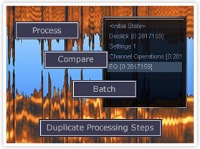Jun 01, 2013 06:37 PM Filed in:
Did You Know?
Most of you reading this know us at Dynamix for creating new sounds with new technology. But did you know we also like to resurrect old sounds? Just twenty years ago, magnetic tapes and records were standard formats we worked with everyday. Now, they're just "antiques" and items taking up space in a closet. But many people are discovering (or re-discovering) analog, and they want it in digital form. For many years, we have been helping people resurrect old recordings by transferring their tapes and records to CD. Many of these analog recordings are of family, but others are important historical archives.
Our main challenge when restoring an old recording is improving the condition of the archive enough to capture an audio signal. Scratches on an old record are obvious, but many are warped, dusty, oily, and even muddy. Reel-to-reel tapes often exhibit "shedding," where the magnetic coating flakes off the acetate base as you play it, destroying it forever. Although not all recordings are recoverable, we've had great success with most. Tapes can be "baked," or slow-heated and slow-cooled to temporarily restore the adhesive that holds the magnetic coating on. Records can be cleaned, and if warped, flattened.
We have a multitude of analog equipment for transferring old recordings, including:
- 1/4" reel-to-reel decks with multiple speeds and track configurations
- A turntable capable of playing 78-,45-, and 33 1/3-rpm records
- Standard-, micro-, and 8-track cassette playback decks
- Digital decks for DAT tapes, ADAT tapes, and minidiscs
Some of the more memorable restoration projects include:
- A 78-rpm recording from 1947 of Man-o-War's funeral that was broadcast on the radio. The record came in warped like a salad bowl.
- An "audio postcard" from a young mother that passed away shortly after its recording. Her son and granddaughter finally heard her voice for the first time.
- Pilot chatter from a practical joke where five seasoned pilots secretly replaced trainees. The instructor had many Barney Fiffe moments as they performed aerial stunts, disregarded orders, and buzzed the tower.
Many old recordings are disappearing quickly. Reel-to-reels are especially fragile because the magnetic material is not only flaking off, it's slowly losing its magnetic field. Another enemy of tapes is temperature fluctuation and mold/mildew from improper storage, such as in attics and basements. Records are at risk from temperature fluctuations as well, especially heat. So be a hero! Take a look around for a treasured recording to rescue.
Did You Know?
A tape that is stored "tails out" means it has to be rewound all the way to the head so it plays forward. Storing a tape "heads out" allows you to play without rewinding - but at a cost. The magnetic coating burns through the layer above it causing a pre-echo effect called "print-through." It's a lot like water leaching through a cloth or print from one page of a book sticking to a facing page. This causes the song to faintly be heard before it actually starts, like in Led Zeppelin's "Babe I'm Gonna Leave You." What about when the tape is stored tails out, is there still print-through? You betcha, but it's post-echo and not usually heard because it's being overpowered by the program.
Dynamix Tech Notes
To use noise reduction or not in old recordings? It depends on the intent of the transfer. If it's a historical archive, the answer is usually no. We sometimes provide an alternate version with noise and scratches reduced, but the official version would be "flat." For anything else, it's all about taste and budget. If it's a music transfer, such as an LP, I often like to make it as pristine as budget will allow. These days, it's easier to do a fast but good sounding cleanup because of mature digital software. For critical transfers, like mastering projects for instance, we spend a lot of time squeezing out as much noise as we can without losing the signal. We may spend a day or two on just one music track.

Our software of choice for noise reduction is Rx2 from iZotope. It's like Photoshop for audio. New and informative ways to look at audio, digital editing tools that didn't exist just 10 years ago, and an intuitive work flow make this the number one choice for professionals. Our most common task in Rx2 is cleaning up location sound, but it's a great tool for easily decreasing tape hiss and record crackle. By taking a snapshot of the noise only (usually the seconds before the program begins on the tape or record), it can be subtracted from the program. Of course it's more complicated than just one step, but Rx2 has bunches of sliders, graphs, and options for us audio nerds.
Neil Kesterson





